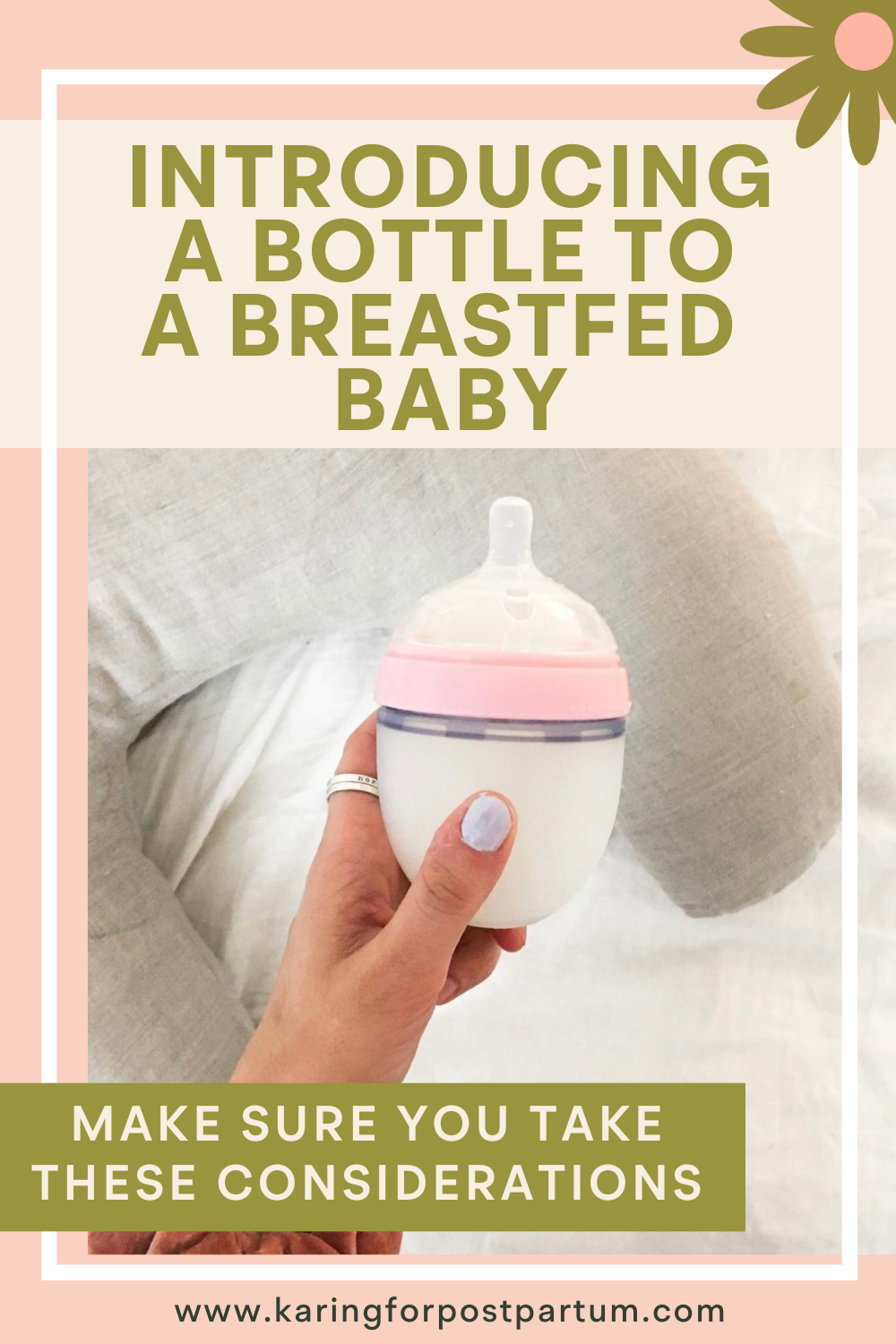Introducing a Bottle to a Breastfed Baby
Okay, so maybe you’re a new mama wondering: when should I start introducing a bottle? Whether you’ll be returning to work, wanting to involve your partner in feedings, or just need an occasional break from nursing—a bottle comes into play for many mamas and babies! It can be nerve wracking when nursing has been going so well, as the term bottle preference pops into our heads! Maybe we have worked so hard to ensure a good nursing relationship with our baby, maybe it was a struggle at first and we finally feel like it’s going well— whatever the case, there are ways to help a baby go between breast and bottle with ease!
Is there a “best bottle” for breastfed babies?
Generally speaking, no. Everyone will have an opinion on “what worked best for their baby”, but that does not mean it’s what’s going to work for yours.
big tip:
Do not buy a million of the same bottles, because you do not know if your baby is going to like that specific bottle or not. Have one bottle from a few bottle brands on hand to start, find what they like, and go from there. Regardless, it’s important to make sure that you have a level one nipple (slow flow nipple). Slow flow nipples encourage baby to put in the same work at the bottle that they do at the breast. This helps decrease the likelihood of a “bottle preference”. If you increase the level of nipple too quickly for a breastfed baby, they can begin to prefer the “faster flow” from the bottle. It’s actually recommended by most LC’s that you continue using a Level 1 nipple through the entirety of your breastfeeding journey.
WHEN TO OFFER
Typically, if breastfeeding is going well, and you won’t be offering a bottle until you return to work, it’s recommended that you wait to introduce a bottle after 4 weeks. This is the recommendation, but is always based on you + your baby’s needs! Essentially, waiting until 4 weeks+ helps establish the breastfeeding relationship and decreases the likelihood of a “bottle preference”. However, if you’re wanting or needing to introduce earlier than this, it’s not going to “ruin” your breastfeeding relationship, mama!
With that being said, it is important to begin introducing a bottle a few times per week when you plan on going back to work. Babies do need some time to start getting used to a bottle if you’ve only been nursing. It’s best not to start the introduction when rushed or only a few days before you go back to work. This way, if there are struggles, you can get the kinks worked out while you’re home with baby- instead of adding unneeded stress for you at work, if your baby is refusing the bottle. Doing these “practice runs” at home at 4 or 5 weeks is also a good way to find out how much your baby is taking in a bottle, so you know how much to send to the sitter. You can start by warming up around 2 ounces (based on your baby’s age), and see how that goes. Your baby can then take the bottle and if they are still hungry, you can then nurse them or add in another ounce or so— this helps give you an idea of what you’ll need to send to the sitter! I do go through some more thorough calculations on determining relatively how much milk to send to the sitter in the “Back to Work” section of my breastfeeding course.
What if I want to introduce the bottle earlier than 4 weeks? You know what is best for you and your baby! All babies are incredibly different. Some do amazing with bottles no matter how early they’re introduced and some can struggle going between breast and bottle. How you give a bottle and the frequency of bottles makes a big difference in the transition, not necessarily the “type” of bottle. Therefore, even if you introduce a bottle day 1 and still want to breastfeed—you can! It’s best to ensure you’re feeding baby properly with the bottle (yes, there is a “method!). I go through best practice on bottle feeding a breastfed baby and paced feedings here.
HOW OFTEN TO BOTTLE FEED
After introducing the bottle, giving your baby 1 bottle per day only 2-3 times a week should be plenty of practice before going back to work. If you are introducing the bottle just for some date nights away, that’s fine also. You do not have to give them a bottle as a routine if you do not want to! If your sitter says that it is a struggle to get them to feed while you are away, you may want to think about offering a bottle a little more consistently at home— this is a great way to involve your partner too! But find what works for you! This is just a general guideline.
PACED FEEDING
The best way to ensure that your baby is not going to struggle with going between breast and bottle is to bottle feed upright and pace their feedings. I learned all about paced feeding when I would float to the NICU at my previous hospital. On TV you may have seen parents holding their baby in a ‘cradle’ position in their arms with the bottle straight up and down in baby’s mouth. Yeah, this is a no-go! Feeding baby this way can signal them that they don’t have to do work at the bottle to get their reward, yet at the breast, they have to put in some work for their reward. What paced bottle feeding does is mimic the breast. It also gives them a chance to realize they’re full— otherwise, babies can tend to easily overeat with the bottle!
okay, so how do I do this?
I have a step by step “paced feeding” how-to in my baby course here. The main goals are:
holding baby in an upright position, while supporting their head properly
holding bottle at a 45 degree angle instead of 90 degree angle to help pace flow of milk
use slowest flow nipple, unless otherwise indicated
take “breaks” and burp baby frequently— this helps pace baby
LET OTHERS DO FEEDINGS
Think about letting your partner or a grandparent feed your baby their first few bottles instead of you. Baby may be used to nursing when they’re with you. You’ve worked hard to establish this, so hand over the bottle to a loved one (when you can!). There are so many pros to having others do the bottle feeds: bonding, less bottle refusal, partner/loved one gets to be involved in the care of the baby and feel important/needed.
but what if it’s a fight to get them to take the bottle?
Make sure that whoever is doing the feeding is using the proper feeding method (pace feeding, noted above). If giving baby a bottle becomes a fight, don’t force the bottle. We don’t want bottle feedings to become an association with frustration (for both mama + baby!). Take a pause, feed baby, and try the bottle again another time. Sometimes it takes a bit for baby to get used to this new sensation. Continue to offer frequently + consistently, but never force. I will link my blog post about bottle refusals here.
HOW MUCH DO I PUT IN THEIR FIRST BOTTLES?
Typically, at around 1 month you can start with 2-3 ounces and increase in ½-1 ounce increments based on hunger cues. This is why it’s a great idea to start while figuring out bottles slowly while you’re at home on maternity leave! It helps you get an idea of how much baby takes in their bottle, and how much you may need to send to daycare when you return to work! I have more about calculating bottle amounts/ how much milk to send to work, etc in my breastfeeding course, with a feeding calculation + a general guideline to follow.
Every baby is different, but typically once a baby shows signs of satiety (hands opening up, falling asleep while taking the bottle, etc.) they’re probably getting close to being done. Make sure you are burping your baby throughout the bottle. If you attempt to offer the bottle again after burping them, and your baby is disinterested/sleepy, they may be finished.
WHEN TO PUMP
You need to be pumping for each feeding your baby gets by bottle in order for your milk supply to continue to meet baby’s demands. So, if your partner is giving your baby a bottle, you need to go pump! We want to make sure that we are still stimulating our bodies to produce the same amount of milk that the baby is taking, to keep up our milk supply + lessen frustration when they go back to the breast.
Take care of yourselves, mamas! If you’ve been confused about bottles, or didn’t know where to begin, I am hopeful this helps! Each mother + baby is different. Some babies need a little extra TLC when getting a bottle, while some transition between breast and bottle with ease! Like motherhood in general, there are always options, mamas!
xx, karrie
Was this helpful? Save it for later!






